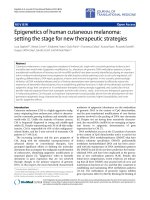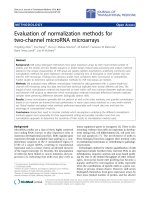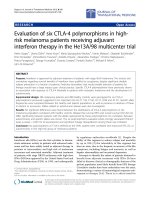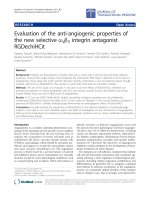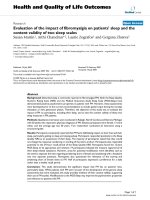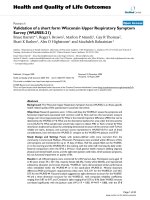Báo cáo hóa học: " Evaluation of a TDMA-based energy efficient MAC protocol for multiple capsule networks" pot
Bạn đang xem bản rút gọn của tài liệu. Xem và tải ngay bản đầy đủ của tài liệu tại đây (1.13 MB, 12 trang )
RESEARCH Open Access
Evaluation of a TDMA-based energy efficient MAC
protocol for multiple capsule networks
Lin Lin
1,2
, Kai-Juan Wong
2*
, Arun Kumar
2
, Zongqing Lu
2
, Su-Lim Tan
2
and Soo Jay Phee
1
Abstract
Wireless capsule endoscopy is a new kind of medical device, which monitors the gastrointestinal tract of the
human body. It can be envisaged that in the future more than one capsule could be ingested by the patient and
they operate collaboratively in the gastrointestinal (GI) tract to perform certain diagnostic and therapeutic tasks.
These mobile capsules and the coor dinator node, which is attached to the abdomen of the patient, form a
wireless network. The capsule devices are typically powered by batteries, therefore, energy efficient medium access
control (MAC) protocols for multiple capsule networks are necessary. This article proposes a novel energy efficient
MAC protocol for multiple capsule networks based on time division multiple access (TDMA). An asymmetric up/
down link network architecture is introduced. A novel TDMA slot assignment scheme is proposed and simulation
results using Qualnet show that the proposed MAC protocol achieves lower energy consumption than B-MAC and
star topology TDMA.
Keywords: multiple capsule networks, MAC protocol, TDMA, asymmetric topology
1. Introduction
Wireless capsule endoscopy (WCE) is a new kind of
medical device, which is ingested by the patient for the
purpose of inspecting the gastrointestinal (GI) tract. Cur-
rently, the commercial WCE is mainly composed of a
camera, a transceiver, and two button batteries [1]. The
camera captures image s of the GI tr act and sends them
to an external data recorder wirelessly. It is envisaged
that, in the future, WCE will be made more vers atile by
providing many advanced functionalities such as active
locomotion, tissue sampling, and drug delivery. It could
also be imagined that several capsules co-operate in the
GI tract to monitor the vital body signs or to perform a
common task [2]. These capsules and the data recorder
(coordinator node), which is externally attached to the
abdomen, form a wireless network that can be viewed as
asubsetofbodysensornetworks(BSN).Figure1shows
an example of the WCE and multiple capsule networks.
The current capsule devices are powered by two 1.5 V,
80 mAh button batter ies. It can last 8 h to perform only
the basic function of capturing and transmitting images
with a frame rate of 2 frames/s [3]. Efficient utilization
of the limited energy is an issue. It is a well known fact
that the radio transceiver consumes a large part of the
energy budget of wireless sensor devices [4] and a good
medium access control (MAC) protocol can efficiently
reduce the e nergy consumed by the transceiver. Many
energy efficient MAC protocols have been propos ed for
wireless sensor networks (WSN) and BSN [5-9]. How-
ever, multiple capsule networks have some unique prop-
erties such as mobility, the size of the operating area,
scalability, safety, reliability, etc., so specific energy effi-
cient MAC protocols for multiple capsule networks are
necessary.
This article proposes a novel energy efficient MAC
protocol for multiple capsule networks based on time
division multiple access (TDMA). The multiple capsule
networks operate only within the body area, thus, the
coordinator radio transmission can cover the entire net-
work area and control all the capsule devices directly.
Based on this, the article proposes a novel up/down link
asymmetric network architecture. For the downlink data
transmissions, the coordinator node sends data directly
to each sensor device, while for the uplink communica-
tions, data are sent via multi-hop mode to the coordina-
tor node. In this way, the power consumption can be
* Correspondence:
2
School of Computer Engineering, Nanyang Technological University,
Singapore
Full list of author information is available at the end of the article
Lin et al. EURASIP Journal on Wireless Communications and Networking 2011, 2011:54
/>© 2011 Lin et a l; licensee Springer. This is an Open Access article distributed under the terms of the Creative Commons Attribution
License (http://creativeco mmons.org/licens es/by/2.0), which p ermits unrestricted use, distribution, and reproducti on in any medium,
provided the original work is prop erly cited.
reduced. A TDMA scheduling scheme is proposed. Each
capsule periodically collects the neighboring information
and sends this information to the coordinator node. The
coordinator node i s the processing center of the whole
network. It calc ulates the best route and time slot sche-
dules, and then sends the schedules back to the cap-
sules. Capsules only wake up in their own slots a nd go
into sleep status for the rest. Adaptive power control is
used in this proposed protocol to further reduce the
energy consumption. Simulatio n results obtained using
the Qualnet simulator showed that the proposed MAC
protocol achieves better performance than B-MAC and
star topology TDMA in terms of energy consumption.
The rest of the article is organized as follows: Section
2 introduces the related works. Section 3 describes
details of the protocol design with the evaluation of its
performance presented in Section 4. F inally, Section 5
concludes the article.
2. Related work s
In WSN, energy wastage is mainly due to collisions, idle
listening, overhearing, and overhead. Many energy effi-
cient MAC protocols h ave been proposed in prior
works. B-MAC [5], S-MAC [6], T-MAC [ 10] are exam-
ples of typical contention-based MAC protocols. They
offer the advantages of simplici ty, small overhead, small
latency, etc. TRAMA [11] and LMAC [12] are typical
schedule-based MAC protocols. Compared with conten-
tion-based MAC protocol, schedule-based MAC proto-
cols can avoid collisions, idle listening, and overhearing
veryeasily.BSN,compared with WSN, has a limited
number of nodes that are attached on the human body
or implanted into the body. The data are gathered from
heterogeneous medical sensors with batteries that are
more difficult to replace. Marinko vic et al. [9] proposed
an energy efficient low duty cycle MAC protocol. It
adopts the TDMA-based strategy and star topology. The
sensor nodes go into sleep mode when they do not have
data to send or receive. However, the pure star topology
used consumes much more energy to transmit sensing
data to the coordinator. HyungTae et al. [13] proposed
an energy efficient mul ti-hop MAC protocol. Minimum
spanning tree routing is utilized and a dynamic time
slot allocation is proposed. The pr otocol is not well su i-
ted to the networks with mobile sensor devices due to
the requirement for fixed data transmission power. This
article adopts the TDMA schedule-based mode for
mobile capsule nodes. An up/down link asymmetric
topology and adaptive power control are used. The
power consumption of the sensor devices is reduced
significantly.
3. Protocol design
3.1. Overview and attributes
Multiple capsule networks are composed of a coordina-
tor node and several capsules moving along the GI
tract. It has several attributes. Firs t, the path-lo ss of the
human body is quite big due to the different electrical
properties of the body tissue [14]; therefore, wireless
communication through the human body is more chal-
lenging than th rough the air. Therefore, higher transmit
power is needed. Secondly, because the capsules are of a
small size around 26 × 11 mm (length × diameter), the
power and resource s for processing on the capsule are
very limited. The coordinator node is typically outside
the human body without size limitation and the
Figure 1 Wireless capsule endoscopy and multiple capsule networks.
Lin et al. EURASIP Journal on Wireless Communications and Networking 2011, 2011:54
/>Page 2 of 12
batte ries are easily replaced, hence the power source for
the coordinator node can be considered to be unlimited.
Thirdly, many sensors could be integrated into capsules
to monitor vital body signs such as temperature, b lood
pressure, electrocardiography (ECG), images of the GI
tract. These sensors may have disparate sampling rate
and sample data size. For example, the pressure and
temperature sampled data may be smaller in size and
lower in sampling rate than the real time image data.
Finally, unlike most WSN, multiple c apsule networks
operate only within the area of the body. This makes
the capsule devices easily reachable from the coordin a-
tor. Based on these unique attributes, the network archi-
tecture, the access and sleep scheme, routing and duty
cycle are discussed below.
3.2. Asymmetric network architecture
This article proposes a novel a symmetric up/down link
topology. It i s a mixture of the centralized architecture
and the distributed architecture (Figure 2). For downlink
data transmissions, because the coordinator node is out-
side the human body with no strict constrain in size,
the radio of the coordinator node could easily cover all
the capsule device s. Based on this, a cen tralized archi-
tecture is adopt ed. The coordinator node is assumed to
have unlimited energy and thus, its energy consumption
is not considered. The total energy consumed by the
capsules to receive data from the coordinator node
directly can be cal culated as the rec eiving energy con-
sumption of the capsule device, E
r
. If the coordinator
node sends data by a multi-hop way through node
group K, then the total energy c onsu mption is equal to
E
r
i
.
E
r
i
and
E
t
i
are the receiving energy consumption
and the transmitting energy consumption of node i(i Î
K), respectively. Obviously t he energy consumption of
the downlink multi-hop communication is larger than
the energy consumption of direct transmission.
For uplink data transmission, because the capsule
devices have very limited power and the batteries are
not easily replac ed, and the path-loss inside the human
body is large, multi-hop communication is considered.
In Equation 1, E
single
istheenergyconsumedbythe
capsule node, which transmits the data directly to th e
coordinator node. It is equal to the summation of E
c
and
E
t
single
. E
c
represents the energy consumed by the
circuitry (i.e., circuitry power) and
E
t
single
is the transmit
energy. In Equation 2, E
ij
represents the total energy
consumed by node i which transmits data to node j.It
is equal to the summation of E
c
and
E
t
ij
.
E
t
ij
is the
transmit energy for sensor node i to transmit data to
sensor node j. ∑
n
E
ij
is the to tal transmit energy con-
sumption for multi-hop communication. The multi-hop
communication can save energy only if ∑
n
E
ij
is smaller
than E
single
(Equations 3 and 4).
E
single
= E
c
+ E
t
single
(1)
E
ij
= E
c
+ E
t
ij
(2)
n
E
ij
≤ E
single
(3)
E
c
+ E
t
single
≥
n
(E
c
+ E
t
ij
)=n × E
c
+
n
E
t
ij
(4)
To evaluate the energy consumption for multi-hop
communications through the human body, a series of
scenarios of different capsules are set up based on a
topology of straight line within the range of 30 cm in
Figure 3. The capsules are uniformly distributed. The
simulation parameters are shown in Table 1. Figure 4
gives the total energy consumption v s. the number of
hops for different circuitry power. Figure 4a shows
the total energy consumption at the circuitry power
of 10 mW. It can be seen that multi-hop communica-
tion consumes less energy than single hop communi-
cation. As the circuitry power goes smalle r, the mul ti-
hop communication becomes more meaningful as
shown in Figure 4b. According to McGregor et al.
[15], at the data rate of 1 Mbps, the circuitry power
consumption can reach 33 μW, so four/five hop com-
munication can be used to save energy for the uplink
data transmission. As discussed above, the uplink,
downlink asymmetric topology gives better perfor-
mance in t erms of the energy consumption.
Data
recorder
Figure 2 Asymmetric link topology.
coordinato
r
capsu
l
es
Figure 3 A series of scenarios for evaluating the multi-hop
communications.
Lin et al. EURASIP Journal on Wireless Communications and Networking 2011, 2011:54
/>Page 3 of 12
Table 1 Parameters for evaluating the multi-hop communications
Parameters Value Parameters Value
Area Straight line of 30 cm Inefficiency factor a 6.5
Number of capsules 1 to 8 Channel frequency 405 MHz
Pathloss model Pathloss matrix Items to send 1000
Radio type ABSTRACT Packet size 1536 bytes
Transmission power
(dBm)
Adaptive CBR packet interval 0.05 s
Energy model GENERIC Simulation time 30 s
Transmission power
(dBm)
15.5, -14.5, -24.5, -29.5, -32.5, -34.5, -35.9286,
-37
Transmit/receive circuitry
power
1.5 μW, 10 μW, 30 μW, 100 μW, 10
mW
(a)
(
b
)
Figure 4 Total energy consumption for different circuitry power consumption.
Lin et al. EURASIP Journal on Wireless Communications and Networking 2011, 2011:54
/>Page 4 of 12
3.3. TDMA Frame format
In multiple capsule networks, because the wireless cov-
erage of t he coordinator node can reach all the capsule
devices, network synchronization can be easily achieved.
Therefore, a TDMA-based MAC protocol is proposed.
The TDMA scheme can avoid collision, idle listening,
and overhearing. It can also maximize the bandwidth
utilization.
In the proposed MAC protocol, time slots are
assigned by the coordinator node. Figure 5 shows the
frame format of the TDMA frame. It is composed of a
number of control slots and data slots. Control slots
include synchronization slot, broadcast slot, power
detection slots, neighboring information upload slots,
and schedule assignment slots. Synchronization informa-
tion is broadcasted by the coordinator node in the
beginning of the frame. All sensors must keep listening
in the first time slot in order to b e synchronized with
the whole network. In the second time slot, the coord i-
nator broadcasts the c ontrol section schedules for all
the capsules. It gives the starting slot for power detec-
tion, neighboring information uploading, and schedule
assignment, respectively. All the capsules receive this
broadcast information and use its own identification
(ID) as the shift to calculate their own tr ansmit time
slot for power detection, neighboring information
uploading, and schedule assignment. In the power
detection section, each sensor broadcasts its own infor-
mation including sensor ID and transmit power in its
own t ime slot. During the rest of the time, it listens for
the p ower detection information of other nodes. I n this
section, the transmit power must be large enough to
ensure that all the other capsules can hear and receive
this neighboring informa tion. In the upload section, the
capsules send the collected information and its time slot
request to the coordinator node. They go into sleep
mode when other nodes send upload data to the coordi-
nator node in order to save energy. After coordinator
node receives all these neighboring information and
time slo t request, it begins to calculate routing and slot
schedule pattern. The time slot assignment is completely
flexible. If a capsule has a lot of data to send, then it
wouldbeassignedmoredataslots.Ifacapsulehasno
data to send, then it would not be assigned data slots.
In the schedule assignment section, the coordinator
node sends the schedules to the capsules. The capsules
only receive in their own slots and during the rest of
the time in this section, they are in the sleep mode. The
schedules includes inform ation about the transmit t ime
slot, receive t ime slot, and the transmit power for the
specific capsule in the following data slot section. In the
data slot section, the capsule devices follow the received
schedules to complete the communications. The whole
process repeats in the next TDMA frame. Figure 6
shows an example of TDMA frame for four capsules in
the network. The packet structures of the control data
are given in Figure 7.
3.4. Routing calculation and adaptive transmit power
control
All the neighboring information are c ollected by the
capsule devices and sent to the coordinator node with
time slot request. The coordinator node calcula tes the
routes, transmit power, and the slot assignment for each
capsule. From the neighboring information, the path-
loss, PL, of any two sensors can be calculated according
to Equation 5 using the transmit power and received
signal strength indication (RSSI). P
t
is the transmit
power f rom node i to node j. RSSI is the receiving
power of node j. The minimum power consu mption,
P
t
ij
(dB)
, of any two sensor devices can be calculated
according to Equations 6 and 7. The coordinator node
generates the matrix of all the possible routes. For each
possible route, the total energy c onsumption is c alcu-
lated as Equation 8.
route
P
t
ij
is the summation of
transmit power in the route.
route
P
r
ij
is the summa-
tion of receive power except the coordinator node. The
receive power consumption of t he coordinator node is
excluded because the coordinator node is outside the
human body, so it is assumed the coordinator node has
unlimited power. The coordinator node calculates the
total power consumption of each possible route and
finds the smal lest one. For this chosen route, the corre-
sponding transmit power can be calculated according to
Equation 6. Algorithm 1 shows the route calculation
algorithm.
PL = P
t
− RSSI
(5)
P
t
ij
(dB) = Sensitivity + PL
ij
+ P
guard
(dB)
(6)
Figure 5 TDMA frame format.
Lin et al. EURASIP Journal on Wireless Communications and Networking 2011, 2011:54
/>Page 5 of 12
P
t
ij
=10
P
t
ij
(dB)
10
(7)
P
tmp
=
route
P
t
ij
+
route
P
r
ij
(8)
Algorithm 1 Route calculation
SET P
comp
< = 1000000, i =0
WHILE i < number of total possible route do
P
tmp
<= 0
P
t
ij
(dB) = Sensitivity + PL
ij
+ P
guard
(dB)
P
t
ij
=10
∧
(P
t
ij
(dB)/10)
P
tmp
=
P
t
ij
+
P
r
If P
tmp
< P
comp
Then
P
comp
= P
tmp
record this route
End if
i = i +1
End While
3.5. Duty cycle analysis
Duty cycle is a very important concept in energy e ffi-
cient MAC protocol design. It refers to the perc entage
of time in active status [9]. It is computed as Equation
9.
DC =
T
active
T
frame
× (1+PER)
(9)
where T
active
is the time duration of active status
within one TDMA frame. T
frame
is the TDMA frame
duration. PER is the packet error rate.
T
active
= T
data
+ T
oh
+
T
sync
N
R
(10)
where T
data
is the time duration for data transmission.
T
oh
is the time duration for overhead transmission. T
sync
is the time duration for synchronization transmission
and N
R
is TDMA resynchronization rate.
DC =
T
data
+ T
oh
+
T
sync
N
R
T
frame
× (1+PER)
=
N
data
+ N
oh
+
N
sync
N
R
f
c
× T
frame
× (1+PER)
=
T
frame
× f
s
+ N
oh
+
N
sync
N
R
f
c
× T
frame
× (1+PER)
(11)
Figure 6 Frame format for a four sensor BSN.
Figure 7 Data packet structures.
Lin et al. EURASIP Journal on Wireless Communications and Networking 2011, 2011:54
/>Page 6 of 12
where DC is the duty cycle, N
data
the sampling data
bits within one frame time, N
oh
the overhead bits within
one frame time, N
sync
the synchronization bits within
one frame time, f
c
the communication data rate (bits
per s) and f
s
the sampling data rate (bits per s).
Generally the lower the duty cycle is, the better the
MAC protocol is designed. The proposed protocol
achieves a low duty cycle by reducing overhe aring and
idle listening.
4. Performance evaluation
The multiple capsule networks inside the small intestine
were simulated using Qualnet 5.0. The energy consump-
tion, latency, and duty cycle of the proposed MAC pro-
tocol were simulated and compared with B-MAC and
star topology TDMA protocol. The results showed that
the proposed MAC protocol outperforms B-MAC and
the star topology TDMA in terms of energy
consumption.
The small intesti ne is about 6 m in length. The mobi-
lity pattern is generated based on the small intestine
model as shown in Figure 8. The moving speed of cap-
sule devices is set to 0.2 mm/s. According to Chirwa et
al. [14], this article estimates the path-loss using dis-
tance between any two capsule devices, d, according to
Equation 12.
PL = d ×
20 dB
10 cm
(12)
B-MAC is used in this article to compare with the
proposed protocol. It is a contention-based MAC proto-
col employing an adaptive preamble sampling scheme to
reduce duty cycle and minimize idle listening. A long
preamble is used before data transmission. Sensor nodes
follow independent sleeping schedule and periodically
wake up to sense the channel. They will remain awake
to receive the messages if they sense the activity on the
channel or go to sleep if they do not detect activities.
To get an optimal setting for B-MAC such that the
smallest energy consumption can be achieved for the
comparisons, the packet delivery ratio (PDR) vs. trans-
mit power and the energy consumption vs. sleep interval
for different number of nodes are simulated. From Fig-
ure 9, it can be seen when the transmit power reaches
-5 dBm, the data recorder can receive 100% data. There-
fore, -5 dBm is used as the B-MAC transmit power. The
optimal B-MAC sleep interval, which achieves the smal-
lest energy consumption for specific network size, is
simulated in Figure 10.
Star topology TDMA is referred to Marinkovic et al.’s
study [9]. The capsule devices and coordinator node
communicate in a point-to-point mode. The frame is
equally divided into small slots and each small slot is
composed of the link packet, acknowledgement packet,
and idle time. The sma ll slots are equally assigned to
capsule devices in advance. The transmit power of the
star topology TDMA is set to -2 dBm which is the mini-
mum transmit power required to ensure a delivery ratio
of 1.
For the proposed TDMA protocol simulation, 405
MHz is used as the wireless communication frequency.
The payload size for synchronization, power detection,
and scheduling assignment is defined as 10 bytes and
the payload size for broadcasting and neighboring infor-
mation uploading is defined as 10 × N,whereN is the
number of the sensor devices. The total energy
Figure 8 Mobility pattern for multiple capsule networks.
Lin et al. EURASIP Journal on Wireless Communications and Networking 2011, 2011:54
/>Page 7 of 12
consumption is calculated as the summation of the
energy consumption of the t ransmit, receive, and idle
states for all the capsule nodes. In our model, the power
consumptionintransmitmodeiscomposedofthe
transmit circuitry power consumption and transmission
signal power consumption, and the power consumption
in receive/idle mode is equal to the receive circuitry
power consumption. The si mulat ion parameters used in
Qualnet are listed in Table 2.
All the simulations for the three MAC protocols
obtain the packet delivery ratio of 1. Figure 11 shows
the energy c onsumptions based on different number of
capsules for the proposed TDMA, B-MAC, and the star
topology TDMA. It can be seen that the energy
consumption for the proposed TDMA is much smaller
than that of B-MAC and star topology TDMA. The pro-
posed TDMA scheme reduces the idle listening and
overhearing compared with B-MAC. The adaptive
power control enables the proposed protocol to use less
transmit power for data communications.
Figure 12 shows th e energy consumption vs. packet
size from 0.5 to 3 kB. The same result that the proposed
TDMA consumes much less energy than B-MAC and
TDMA in [9] is obtained. Figure 13 gives the simulation
of energy consumption vs. constant bit rate (CBR)
packet interval. The proposed TDMA achieves signifi-
cant performance gain for CBR packet interval from 200
ms to 1 s.
Figure 9 Packet delivery ratio vs. transmit power for B-MAC.
Figure 10 Optimal sleep interval for B-MAC for various network sizes.
Lin et al. EURASIP Journal on Wireless Communications and Networking 2011, 2011:54
/>Page 8 of 12
Table 2 Parameters used in simulation.
Parameters Value Parameters Value
Area 0.4 m × 0.4 m Transmit/receive circuitry power 33 μW
Number of capsules 2 to 6 MAC protocol TDMA, B-MAC
Channel frequency 405 MHz Mobility pattern Small intestine
Pathloss model Pathloss matrix Items to send 20000
Radio type ABSTRACT Packet size 512 Bytes to 3 kB
Transmission power (dBm) Adaptive CBR packet interval 0.2 to 1 s
Energy model GENERIC Simulation time 20000 s
Inefficiency factor a 6.5
Figure 11 Energy consumption vs. number of capsules.
Figure 12 Energy consumption vs. packet size.
Lin et al. EURASIP Journal on Wireless Communications and Networking 2011, 2011:54
/>Page 9 of 12
However, for the delay performance, the proposed
TDMA shows worse performance than B-MAC and star
topology TDMA. Figure 14 gives the average end-to-end
delay. B-MAC and the star topology TDMA manage to
consistently achieve a stable low latency for different
network capacity. While for the proposed TDMA, the
average end-to-end delay is very large and it increases
when the network capacity becomes larger. This is due
to the adaptive power control. The routing is calculated
for achieving lower energy consumption. More hops can
obtain lower energy consumption but cause larger
delays at the same time. Another reason for the unfa-
vorable delay performance is the TDMA frame format.
In the TDMA frame format proposed, the data slots are
followed by the control data slots. This would cause
delay if the data is supposed to be sent during the con-
trol data section. The assigned slots would also intro-
duce delay. For example, data transmission may be
finished before the end of the slot, but other data trans-
mission cannot start until the next slot. Further work
will be done to mi nimize the latency of the proposed
protocol.
Figure 13 Energy consumption vs. CBR packet interval.
Figure 14 Average end-to-end delay vs. number of capsules.
Lin et al. EURASIP Journal on Wireless Communications and Networking 2011, 2011:54
/>Page 10 of 12
Figure 15 shows the duty cycle of the proposed
TDMA, B-MAC, and star topology TDMA. The duty
cycles of the two TDMA protocols are much lower than
that of B-MAC, which means that the TDMA protocols
sleep longer time than B-MAC. The duty cycle of the
proposed TDMA is bigger than star topology TDMA
because of larger overhead and the multiple transmis-
sions of the same data. However, since the capsule uti-
lizing the proposed protocol will be transmitting with
lower transmission strength, the overall energy con-
sumption will still be lower than when star topology
TDMA is utilized as previously presented in Figure 11.
5. Discussion and conclusion
This article proposed a TDMA based MAC protocol for
multiple capsule networks. A novel asymmetric up/
down link topology was used which is better than the
pure star topology or distributed topology. In the pro-
posed algorithm, capsules periodically send neighboring
information to the coordinator node. The coordinator
node then calculates the routing schedule for each cap-
sule and sends these back to the capsules. The proposed
protocol can avoid the idle listening and overhearing
problems and many tasks are shifted to the coordinator
node side to process. Simulation results showed that the
proposed TDMA protocol achieves better performance
than B-MAC and star topology TDMA in t erms of
energy consumption.
A few important issues pertaining to the operation of
such in-body net works are discussed as follow. First, the
objective is for health monitoring inside the human
body, so safety and reliability are serious considerations.
Safety and reliability must not be compromised even if
higher cost is induced. Secondly, the frequency for
power detection is dependent on the speed of the
mobile sensors. If it is slow compared with the speed of
capsules, then the path-loss may vary very much and
the calculated trans mit power becomes inaccurate. This
inaccuracy will cause transmit power variations where;
when it is set too small, it will cause packet loss; other-
wise when it is set too high, it will result in energy
wastage. Thirdly, the latency for the proposed TDMA is
quite long. There are two rea sons for this characteristic.
One is the multi-hop communication and the other is
the TDMA frame pattern. Further optimization for
reducing the average end-to-end delay is expec ted and
will be explored in future work. Finally, this articl e pro-
posed a novel medium access solution for wireless cap-
sule networks inside GI tract. This can also be a
referenceforthefuturecomplexbodysensornetworks.
The future works would focus on optimizing power
detection frequency and re ducing the average end-to-
end delay.
List of abbreviations
BSN: body sensor networks; CBR: constant bit rate; ECG: electrocardiography;
GI: gastrointestinal; ID: identification; MAC: medium access control; PDR:
packet delivery ratio; RSSI: received signal strength indication; TDMA: time
division multiple access; WCE: wireless capsule endoscopy; WSN: wireless
sensor networks.
Acknowledgements
This study has been supported by Singapore’s Agency for Science,
Technology and Research (ASTAR) under the grant No. 082 140 0036.
Figure 15 Duty cycle vs. number of nodes.
Lin et al. EURASIP Journal on Wireless Communications and Networking 2011, 2011:54
/>Page 11 of 12
Author details
1
School of Mechanical and Aerospace Engineering, Nanyang Technological
University, Singapore
2
School of Computer Engineering, Nanyang
Technological University, Singapore
Competing interests
The authors declare that they have no competing interests.
Received: 22 June 2011 Accepted: 4 August 2011
Published: 4 August 2011
References
1. Given Imaging (20 Jan 2011). Given Imaging
2. L Lin, K-J Wong, S-L Tan, S-J Phee, Asymmetric multihop networks for
multi-capsule communications within the gastrointestinal tract, in Wearable
and Implantable Body Sensor Networks, 2009. BSN 2009. Sixth International
Workshop on, pp. 82–86 (2009)
3. D Lan-Rong, W Yin-Yi, A wireless narrowband imaging chip for capsule
endoscope. Biomed. Circuits Syst IEEE Trans. 4, 462–468 (2010)
4. K Kredo, P Mohapatra, Medium access control in wireless sensor networks.
Comput Netw. 51, 961–994 (2007). doi:10.1016/j.comnet.2006.06.012
5. P Joseph, H Jason, C David, Versatile low power media access for wireless
sensor networks. Presented at the Proceedings of the 2nd international
conference on Embedded networked sensor systems, Baltimore, MD, USA
(2004)
6. Y Wei, J Heidemann, D Estrin, An energy-efficient MAC protocol for wireless
sensor networks, in INFOCOM 2002. Twenty-First Annual Joint Conference of
the IEEE Computer and Communications Societies. Proceedings. IEEE. 3,
1567–1576 (2002)
7. WB Heinzelman, AP Chandrakasan, H Balakrishnan, An application-specific
protocol architecture for wireless microsensor networks. Wireless Commun
IEEE Trans. 1, 660–670 (2002). doi:10.1109/TWC.2002.804190
8. O Omeni, ACW Wong, AJ Burdett, C Toumazou, Energy efficient medium
access protocol for wireless medical body area sensor networks. IEEE Trans
Biomed Circuits Syst. 2, 251–259 (2008)
9. SJ Marinkovic, EM Popovici, C Spagnol, S Faul, WP Marnane, Energy-efficient
low duty cycle mac protocol for wireless body area networks. IEEE Trans
Infor Technol Biomed. 13, 915–925 (2009)
10. D Tijs van, L Koen, An adaptive energy-efficient MAC protocol for wireless
sensor networks, Presented at the Proceedings of the 1st international
conference on Embedded networked sensor systems, Los Angeles,
California, USA, (2003)
11. V Rajendran, K Obraczka, J Garcia-Luna-Aceves, Energy-efficient, collision-
free medium access control for wireless sensor networks. Wireless Netw. 12,
63–78 (2006). doi:10.1007/s11276-006-6151-z
12. S Chatterjea, LFW van Hoesel, PJM Havinga, AI-LMAC an adaptive,
information-centric and lightweight MAC protocol for wireless sensor
networks, in Intelligent Sensors, Sensor Networks and Information Processing
Conference, 2004. Proceedings of the 2004, pp. 381–388 (2004)
13. K HyungTae, L SuKyoung, Energy-efficient multi-hop transmission in body
area networks, in Personal, Indoor and Mobile Radio Communications, 2009
IEEE 20th International Symposium on, pp. 2142–2146 (2009)
14. LC Chirwa, PA Hammond, S Roy, DRS Cumming, Electromagnetic radiation
from ingested sources in the human intestine between 150 MHz and 1.2
GHz. IEEE Trans Biomed Eng. 50, 484–92 (2003). doi:10.1109/
TBME.2003.809474
15. I McGregor, G Whyte, K Elgaid, Low complexity, 165 uW, 5 Mbit/s wideband
radio front-end with range of several meters, in Microwave Symposium
Digest, 2009. MTT ‘09. IEEE MTT-S International, pp. 397–400 (2009)
doi:10.1186/1687-1499-2011-54
Cite this article as: Lin et al.: Evaluation of a TDMA-based energy
efficient MAC protocol for multiple capsule networks. EURASIP Journal on
Wireless Communications and Networking 2011 2011:54.
Submit your manuscript to a
journal and benefi t from:
7 Convenient online submission
7 Rigorous peer review
7 Immediate publication on acceptance
7 Open access: articles freely available online
7 High visibility within the fi eld
7 Retaining the copyright to your article
Submit your next manuscript at 7 springeropen.com
Lin et al. EURASIP Journal on Wireless Communications and Networking 2011, 2011:54
/>Page 12 of 12




